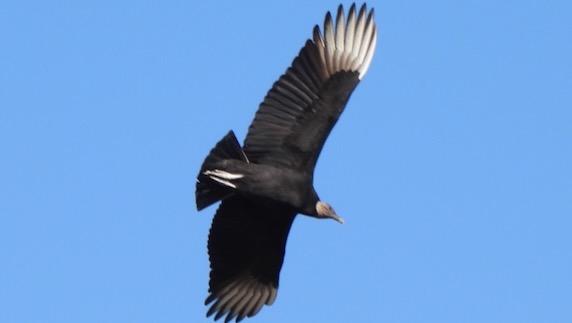
A black vulture circles over Sheri Capehart Nature Preserve in Arlington in 2024. Photo by Sam Kieschnick.
What’s that big bird on the road eating a dead squirrel? A vulture!
They can be quickly ID'd by most casual bird watchers but these large, bald-headed birds with their ghoulish looks, taste for roadkill and reputation as bad omens give them a spooky persona.
Even the name vulture is a derogatory term meaning a person who preys on others.
Texas is home to two vulture species — the turkey vulture, with its pink bald head, and the black vulture, with white bands on the tips of its wings and a dark colored head. Both species are present in North Texas.
While these birds may be off-putting to some, their role in our ecosystem is important. Efforts are being made to challenge the negative perception of vultures.
In Denton at the University of North Texas' Discovery Park, a family of black-headed vultures has caught the eye of the student body. The birds’ presence has both provided the opportunity to observe their way of life and as well as inspire empathy for them as sentient beings.
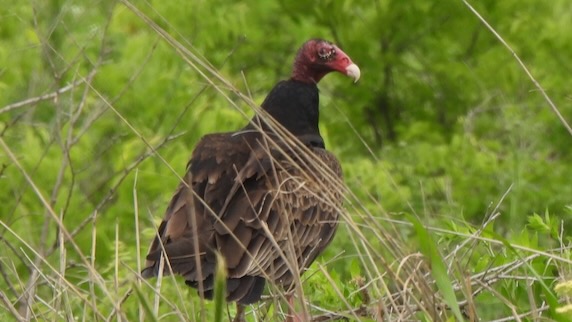
CLEANUP CREW
The primary eco-service of vultures is to remove, eat and clean up carrion both on the roads and in the wild.
“They are big scavengers,” says Sam Kieschnick, DFW-based urban wildlife biologist with Texas Parks and Wildlife. “What that means is that they can clean up big road kills.”
When an animal dies, vultures are the first ones on the scene. And while there are other scavengers, vultures tend to clean things up quicker and more efficiently.
And although vultures have sharp beaks and talons, they do not typically kill animals.
Kieschnick says in some instances, black vultures can be a concern for cattle ranchers.
“As a young calf is birthed or pretty vulnerable, sometimes that black vulture will go in and kill the baby calf.”
However, that is not that common.
YEAR-ROUND RESIDENTS
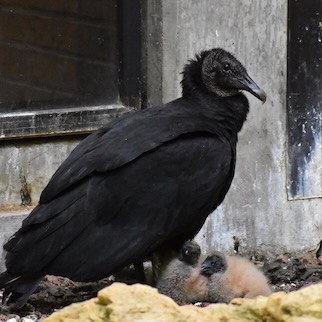
While most people picture vultures crouched over a grisley scene, the Vulture Cam at UNT is providing an alternative image.
Ashley Giron, chair of the UNT Bird Campus Committee, and Mack Davis, co-chair, both lead the Black Vulture Camera Project, a project created to observe the black vulture family at UNT Discovery Park.
While the installation for the cameras began in February of this year, the plan took flight nearly a year earlier.
“We wrote the grant beforehand, so this whole process started back in March of 2024,” said Giron.
Davis said the project aims to educate people on vultures — to see past stereotypes, learn what they’re up to in their daily lives and help protect them.
Davis and Iron explain that this project came to life after they were contacted about the vultures by facility tenants who saw them from their building windows.
“They also noted that [the vultures] have been here for some consecutive years now. So we felt that it would be good to implement this monitoring program,” Giron explained.
The vulture family has been at UNT Discovery Park and the surrounding area year-round.
“Even though the current chick that is there has fledged, and has left the nest, they still hang around that area,” Davis said. “The parents and the chicks are still in the general vicinity of Discovery Park, but they are currently still using that nesting site.”
The vultures have also been seen in other parts of UNT Discovery Park, specifically the Pecan Creek Pollinative Prairie.
“We know for sure of the three black vultures, but that’s not to say that there aren’t other vultures that visit the area. But for sure there are the three that are there year-round,” said Davis.
PARENTING PARTNERS
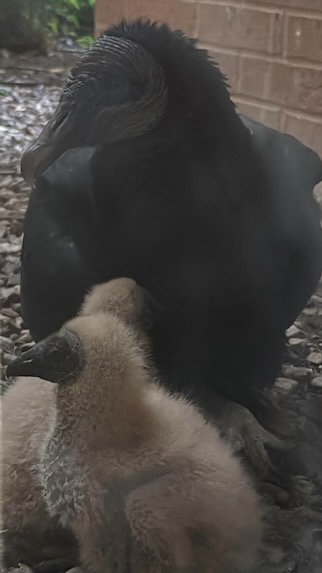
As for the domestic life of the Discovery Park vulture family, both vulture parents partake in caring for their chicks, which look like white puff balls.
“Both vultures will take care of typically one or two babies, sometimes three. They put a lot of parental care into those babies,” Kieschnick of TPWD said.
Davis agreed that vultures make excellent parents. He added they don’t build typical nests.
“What we’re seeing at Discovery Park is that vultures are just laying their eggs on the ground,” said Davis. “What we’re seeing is that for the first couple months, the mom laid eggs and then the chick hatched. Mom was there all the time. And then once the chick got older, you would see Mom leave, go get food, come back. Sometimes Dad would come in with food, sometimes both parents would be there.”
Giron also mentioned that vultures usually do not nest in high traffic areas. However, UNT Discovery Park has extremely high traffic, which makes their presence interesting.
Though the Discovery Park vultures have picked a rather active place to nest, when it comes to raising their young, vultures typically nest in more secluded areas, such as barns or sheds. In more remote settings, vultures will nest under cliffs or in rock crevices.
“Over in Cedar Hill State Park, they use some of the old historical barns to create their nests,” Kieschnick said.
A pair of Cedar Hill State Park vultures, are named Morticia and Gomez Addams.
FLOCKING TOGETHER
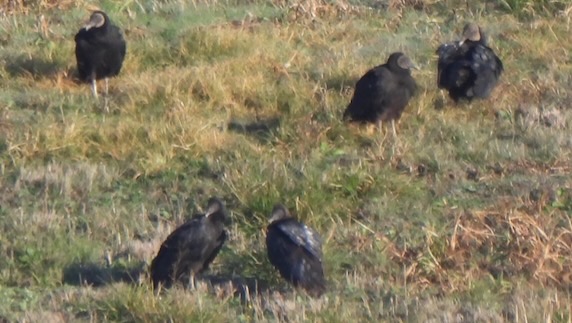
In general, vultures are a very community-oriented species. As a rule, vultures typically stick together.
“They are gregarious.” Kieschnick explained, meaning they tend to stay together in groups. “We will sometimes see them flying around, even in multiple species. You’ll see the black vulture and the turkey vulture kind of hanging out.”
In areas with powerlines or radio towers, large groups of vultures gather into huge colonies.
“They typically do go together, although it’s not uncommon to see them by themselves too,” Kieschnick said.
UNFAIRLY MALIGNED
Addressing the negative stigma surrounding vultures, Kieshnick emphasized how they are a very misunderstood bird.
“People tend to think vultures are an omen of death. Well no,” he countered.
If you think about it, it’s just the opposite.
“Without vultures, we would have so much smelly roadkill all over the place,” he said. “It would take much longer for the bugs and for other critters to do the same service that our vultures are doing now.”
Vultures have been killed over fears that they spread disease but the birds actually reduce the spread of disease, according to the Cornell Lab of Ornithology Bird Guide
Kieschnick shared many more interesting facts about vultures.
For example, since they cannot sweat like humans do, they cool down by urinating and defecating on their legs.
And if you wonder how vultures can eat rotting roadkill and not get ill, it’s because their stomach acid is extremely strong, able to dissolve disease and bacteria carrying carrion.
“It’s like battery acid,” he explained. “They don’t get sick by eating things that have e coli, or viruses and other potentially deadly things.”
All in all, vultures do essentially more than they are given credit for. Similar to Kieschnick, the UNT Discovery Park Vulture Cam Project hopes to shed light on these much maligned creatures.
“It’s purpose is to kind of change that public opinion on them. To show — hey, look they have cute babies, and their cute little families. But also, they are good for the environment,” Davis said. “Without them, we would have disease spreading from road kill.”
Giron goes on to add that vultures are not simply birds but they are “part of our community” as well.
Sharing similar sentiments, Kieschnick emphasized the importance of educating ourselves on vultures.
“Vultures are worthy of our appreciation. They are crazy cool, super super interesting, and they are doing such a tremendous service to the entire eco system.”
Not only do they clean up road kill — they do it all free of charge.
Lastly, Kieschnick stressed the importance of educating one's self on all of the wildlife we share our communities with — especially the ones we fear and shun.
“Learning is one way that we can alleviate any kind of fear, whatever it may be,” he added. “When we learn about things, we start to appreciate them and alleviate some of our fears.”
